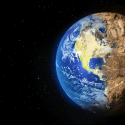As Earth’s population multiplies each year, we’re quickly running out of resources to feed the planet. Before long, we’re going to need more space to grow. So, have you ever thought about being a moon farmer?
What technology is needed to farm the Moon? How much food could we produce on the Moon? How much would it cost to ship it back to Earth?
With over 37 million square kilometers (14.3 million square miles), the Moon has enough land to farm 75% as much as we do on Earth today. We are currently farming about 50% of Earth’s habitable land. Out of all that land, 71% is to provide food and pastures for livestock. To put it simply, we’re running out of space to grow food.
While vertical farming could be a viable space-saving solution in the meantime, we’re still going to need more space before long. Thankfully, scientists from NASA and the China National Space Administration (CNSA) have been conducting experiments to see if growing food in low to zero gravity environments is a possibility.
So, could we actually grow veggies on the Moon? And how much would it cost?
Well, in early 2019, China’s Chang’e 4 rover landed on the dark side of the Moon carrying vegetable seeds and insect eggs. This Lunar Micro Ecosystem provided a miniature greenhouse complete with water, air, soil, and heating. Before long, the seeds sprouted and flies hatched, creating a biological synergy. Cottonseed, potato seed and rapeseed had sprouted, leading scientists to believe that lunar greenhouses are indeed feasible.
NASA has been working on its own growing system geared toward space colonies. The Vegetable Production System, aptly named ‘Veggie,’ is a garden aboard the International Space Station used to study plant growth in microgravity. In order to distribute water, nutrients, and air, each plant grows in a ‘pillow’ filled with a clay-based growth medium to keep the plant from drowning. Without gravity, these plants use light to orient themselves and guide their growth. Veggie has successfully produced a variety of greens for astronauts to snack on and research. Mmm, space salad!
NASA is also developing the Prototype Lunar/Mars Greenhouse project. This inflatable hydroponic greenhouse could be buried under the lunar soil, known as ‘regolith,’ to protect crops from harmful solar radiation. Using fiber optics, sunlight would be redirected into the chamber using LEDs. The carbon dioxide (CO2) emitted when astronauts breathe would enhance the growth of the crops, and in turn, produce more oxygen (O2). As for water, it could be initially brought from Earth and even sourced from lunar craters.
So, it seems like growing on the Moon is possible, but could we afford it? Okay, time for a little accounting. It costs about $60,000 U.S. dollars per 1 kilogram (2 lb) to send cargo into space. A space shuttle can carry about 23,000 kg (50,000 lb) of cargo. In 2017, the weight of the world’s tomatoes was about 3500 times that of the great pyramid of Khufu.
To ship this back to earth would cost more than 13,000 times the world’s gross domestic product (GDP). That’s several trillions of dollars. It would also require 791 million trips with our current space shuttle. This means, moon vegetables would be an incredibly expensive luxury item. We’re talking about somewhere close to a year’s salary for a tomato. Uhh, check please!
Unfortunately, moon farming to feed the Earth doesn’t look like it’s happening anytime soon. But at the very least, the ability to grow food in moon-like conditions means the future is bright for space colonies. Maybe we’d be better off building a giant lunar colony to offset the Earth’s growing population.
Subscribe to What-If on YouTube or follow the show on Facebook Watch.
Sources
- “Crop growth and viability of seeds on Mars and Moon soil simulants”. Wamelink, G.W.W., J.Y. Frissel, W.H.J. Krijnen, and M.R. Verwoert. 2019. Open Agriculture 4 (1): 509-516. doi:10.1515/opag-2019-0051.
- “Space Farmers Could Grow Crops In Lunar And Martian Soil, Study Suggests”. Smithsonian Magazine.
- “Moon Fact Sheet”. 2020. nssdc.gsfc.nasa.gov.
- “Earth Overshoot Day 2020 – Earth Overshoot Day”. 2020. Earth Overshoot Day.
- “Growing Plants In Space”. 2020. NASA.
- “Africa Is Way Bigger Than You Think”. Fischetti, Mark. 2015. Scientific American Blog Network.
- “Half of the world’s habitable land is used for agriculture”. 2019. Our World In Data.



























